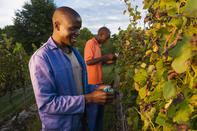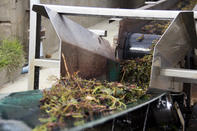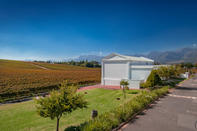Grape Picking
At first glance, the process of wine-making seems simple enough: you gather grapes, compress them into tanks and wait for some time to pass - and “voila!” you have wine. However, winemaking is a far more complex and rigorous process.

Although there is no specific recipe to winemaking, there are a lot of processes and techniques which are used to produce different types of wine. All the different processes of winemaking have the same first step - picking the grapes!
Grape picking is all about timing. Unlike avocados and bananas, grapes don’t ripen after you pick them so you have to wait for the right moment. If the grapes are picked at a slightly less ripened stage then they will produce wines with a higher acidity, like white or sparkling wine. If the grapes are more ripe then the wines will have a much sweeter concentration, like late-harvest dessert wines. Sometimes the conditions the grapes are grown in affect how well they ripen - this is why some vintage wines taste better than others.
Craft of Winemaking

Vinification or winemaking is the production of wine, which begins with the harvesting of fruit, fermentation and finally the bottling of the luscious liquid. Well, at least that’s the Sparknotes version of the process. The real craft of wine-making involves a far more intricate dance of steps to ensure a delicious brew of South Africa’s finest grapes. Once the grapes have been picked and delivered to the winery, that’s when the real process begins!
The winery begins by sorting, squeezing and nudging the grapes, which are not washed, into submission. The grapes aren’t washed to prevent the quality of the fruit’s concentration from being ruined.
The grapes are then separated into red wine grapes, like Cabernet Sauvignon, and white wine grapes, like Chardonnay, and then placed on sorting tables to remove “MOG” - that’s the industry jargon for ‘materials other than grapes’. Red wines are made from black grapes and have a red or blue tint, while white wines are made from greenish or yellow grapes.
Red wine grapes often keep their thin skins and stems when they are fermented to add tannin (bitterness), while white wine grapes have their thicker skins and stems removed before fermentation, as it will make the wine too bitter. The next step is to transfer the liquid to fermentation tanks, which come in different shapes and sizes. The three most-used types are wood, stainless steel and concrete - each comes with unique traits that affect how the wine ferments. While fermentation takes place, yeast is added to the mix. Winemakers can opt for commercial or ‘wild’ yeast, the latter a more natural method.
Fermentation allows for the consumption of sugar in the grapes, which ultimately turns into alcohol. Red wines ferment at a high temperature, usually around 27ºC, while white wines ferment at a cool 10ºC to keep its delicate aromas in tact. As the wine ferments, carbon dioxide is released, which causes grape seeds and skins to rise to the surface. Winemakers can then ‘punch down’ the cap to control it, or ‘pump over’, which is the preferred method as the juice from the bottom is gently poured over the top of the skins and seeds.
After fermentation, the juice is released from the tank through a rack, and juice that runs free (without being pressed) is generally considered the purest, highest quality wine. The rest of the wine is “press wine” and is generally slightly more rustic. Wines then go into barrels, bottles, or storage tanks. Some wines will wait for five years before being released; others, just a few weeks. During this time, wines are racked, tested, tasted, stirred (lees stirring), and often blended together to create a final wine.
Brief History of Winemaking

If you hear anyone speak of visiting South Africa, a trip to the Cape Winelands is bound to be on their agenda. For 350 odd years, South Africa has been growing and producing world-class wines. Its main production region, the Cape Winelands, has a history as rich as its wine.
The roots of the South African wine industry can be traced back to the establishment of the Cape Colony as a re-supply and layover port for vessels of the Dutch East India Company’s trade with Asia. Back then Cape Town was only a half-way station for ships to recharge their supplies on their journey along the spice route to India. The settlement grew and along with it, farming. Grape farming became popular because people believed that eating grapes and drinking the wine created from them would prevent scurvy and diseases between the sailors during their long travels.
Just as it is one of South Africa’s tourist hubs now, back in the 18th and 19th century the Cape, or more specifically its wine, pulled in a lot of traffic to South African shores. Cape wine made its debut in 1959 from French Muscadel grapes and a couple of centuries later was made famous by Napoleon Bonaparte and Jane Austen, who drank and wrote about the sweet-tasting Constantia wine. Luckily for tourists and locals alike, that delectable Cape wine is still being produced.